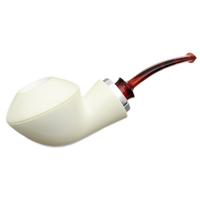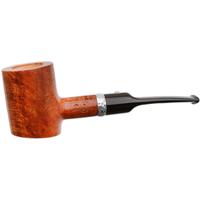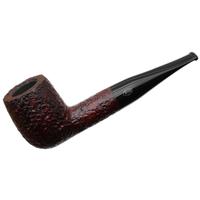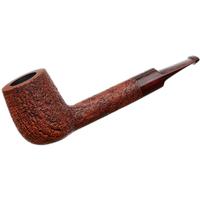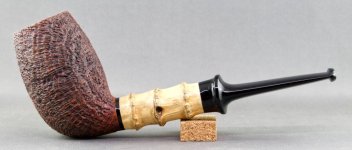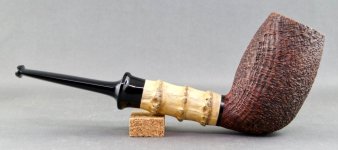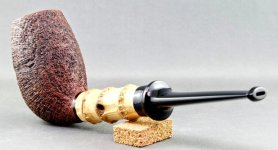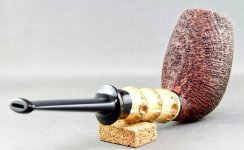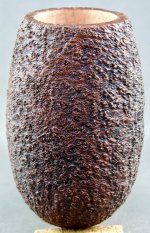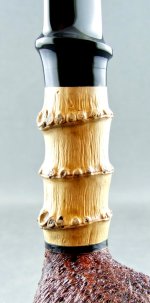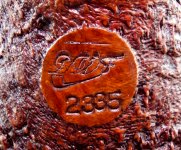Spectacular Doug Finlay XL Bamboo Belge
- Thread starter georged
- Start date
You are using an out of date browser. It may not display this or other websites correctly.
You should upgrade or use an alternative browser.
You should upgrade or use an alternative browser.
Beautiful, especially the blasting. I was trying to find a place for a pin to hold the bamboo to the stummel, but I didn't see any. After a post you made last year about the Dunhill bamboos, I've been checking out all bamboos to see if they have any.
This is absolutely stunning as a whole, but I am curious, @georged , does the bamboo connection have something that I am missing that elevates this one above all of the other bamboo pipes? Your post last year seamed to suggest that artisan bamboos were sub-par. Or, did I just misinterpret what you were saying last year?
Thanks for bringing this pipemaker to our attention.
This is absolutely stunning as a whole, but I am curious, @georged , does the bamboo connection have something that I am missing that elevates this one above all of the other bamboo pipes? Your post last year seamed to suggest that artisan bamboos were sub-par. Or, did I just misinterpret what you were saying last year?
Thanks for bringing this pipemaker to our attention.
That pipe is incredible!! I remember when you were impressed with the pipes that were made with the double chamber!!
Beautiful, especially the blasting. I was trying to find a place for a pin to hold the bamboo to the stummel, but I didn't see any. After a post you made last year about the Dunhill bamboos, I've been checking out all bamboos to see if they have any.
This is absolutely stunning as a whole, but I am curious, @georged , does the bamboo connection have something that I am missing that elevates this one above all of the other bamboo pipes? Your post last year seamed to suggest that artisan bamboos were sub-par. Or, did I just misinterpret what you were saying last year?
Dunhill's pinning method of bamboo attachment is definitely mechanically superior. There is only one way to do it, and failure of the connection is literally impossible unless the strength of the materials is exceed. Also, it does not degrade over time.
Using metal tubing and adhesives falls on a spectrum. If you are mechanically minded, understand the stresses and tolerances involved, and the properties of the bamboo and metal tubing being used, and the properties of the adhesive used, and mix it correctly in both time and proportion, and it hasn't exceeded it's shelf date, and the joint wasn't moved before full cure was achieved---the end result is solid. If you don't, the pipe comes apart. (And fixing it will be a major PITA for many reasons).
The root problem is a percentage of pipemakers are "shape imaginers" first and concern themselves little with technical stuff. "Make it look like X, and make sure it has a short fat hole in it connected to a long thin one" is the entirety of the situation in their mind.
Their bamboo pipes come apart.
Those carvers who understand that pipes are quasi-mechanical tools, not just static 3D exhibits, and do all the right stuff when designing and putting together multi-component ones, do not have their bamboo pipes come apart.
Doug is 100% one of the latter. (Arguably the benchmark... he's been a professional auto/shop mechanic for a third of a century.)
Nice! That is one long smoke.
Indeed it is.
Rich Esserman has said for decades that jumbo chambers give a qualitatively different smoking experience that some people think is better, so I gave it a whirl several years ago.
I agree with him 100%. This bamboo blege is my fourth "Esserman class" pipe.
I've posted pics before at various times - just added my fourth from Doug around Thanksgiving - couldn't be happier with the way they perform and the attention to detail! Each one was the result of a specific idea and he's a good listener in addition to being a fine craftsman, and also good at gently explaining why something assumed to be workable may not be ideal. Every experience has been positive from start to finish. It was a pipe of Doug's that George posted that caught my attention that led to me contacting Doug to begin with.
How does Doug’s numbering work? Is that his 2335th pipe or is it his 35th pipe of 2023 or something else?
PS ---
Since someone is sure to ask, no, the bamboo has not been sandblasted.
There are varieties that simply look that way/grow that way. Striated instead of smooth between the knuckle-thingies.
Since someone is sure to ask, no, the bamboo has not been sandblasted.
There are varieties that simply look that way/grow that way. Striated instead of smooth between the knuckle-thingies.
Is the correct answer.How does Doug’s numbering work ? 35th pipe of 2023
On this particular one, the bamboo is significantly large enough to do a delrin tenon that has grooves cut in 2 directions and epoxied in. It would take a quite a bit of torque to break it loose and I'd reckon it'd snap the briar or bamboo first.Beautiful, especially the blasting. I was trying to find a place for a pin to hold the bamboo to the stummel, but I didn't see any. After a post you made last year about the Dunhill bamboos, I've been checking out all bamboos to see if they have any.
This is absolutely stunning as a whole, but I am curious, @georged , does the bamboo connection have something that I am missing that elevates this one above all of the other bamboo pipes? Your post last year seamed to suggest that artisan bamboos were sub-par. Or, did I just misinterpret what you were saying last year?
Thanks for bringing this pipemaker to our attention.
I'm not usually drawn to bamboo stems, but it seems to work on this one. Seems just the right amount to be used, and the knobbiness of the bamboo matches the finish on the bowl.
But how do you stamp it if you make 100 pipes in a year? How do you account for the possibility of you carving in the year 2123?Is the correct answer.
Joking aside, do you think you’ll ever churn out 100 pipes in a year? And is ~30 your normal output now?
In that case, it would be 23100 etc...But how do you stamp it if you make 100 pipes in a year? How do you account for the possibility of you carving in the year 2123?
Joking aside, do you think you’ll ever churn out 100 pipes in a year? And is ~30 your normal output now?
If I make it to 2123, I'll cross that bridge when I get there.
56 completed pipes in 2023, hope to hit 75 in 2024
Dibs on the first pipe that gets marked 100.
Seriously.

Seriously.
It's time for Mr. BooBelge's three-weeks-along Performance Report ---
Smoked every day for 21 days straight. Either GH&Co. Dark Birdseye, Dark Flake, or Brown Bogie.
It's 100% true, guys... If you fill 'em right, giant chambers (2.5" deep and 1" across in this case) have no problem staying lit/smoldering and intensify flavor noticeably.
The stem is so comfy that clenching is no problem at all.
The elongated egg shape of the bowl + the texture of the blast = delightful hand feel and balance.
The alien-y texture of the bamboo is something you never get tired of looking at up close.
Having a bowl last (on average) 2.5 hours is pure crack for your brain's laziness-gratification-feedback-loop.
Score 10 out of 10 in every possible way. How can I say that without reservation? How do I KNOW? Because it smashes the "magic wand test"... i.e. If I had a magic wand and could change the pipe in any way whatsoever with a thought and a touch, I would change nothing.

Smoked every day for 21 days straight. Either GH&Co. Dark Birdseye, Dark Flake, or Brown Bogie.
It's 100% true, guys... If you fill 'em right, giant chambers (2.5" deep and 1" across in this case) have no problem staying lit/smoldering and intensify flavor noticeably.
The stem is so comfy that clenching is no problem at all.
The elongated egg shape of the bowl + the texture of the blast = delightful hand feel and balance.
The alien-y texture of the bamboo is something you never get tired of looking at up close.
Having a bowl last (on average) 2.5 hours is pure crack for your brain's laziness-gratification-feedback-loop.
Score 10 out of 10 in every possible way. How can I say that without reservation? How do I KNOW? Because it smashes the "magic wand test"... i.e. If I had a magic wand and could change the pipe in any way whatsoever with a thought and a touch, I would change nothing.




